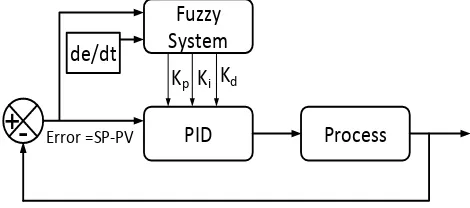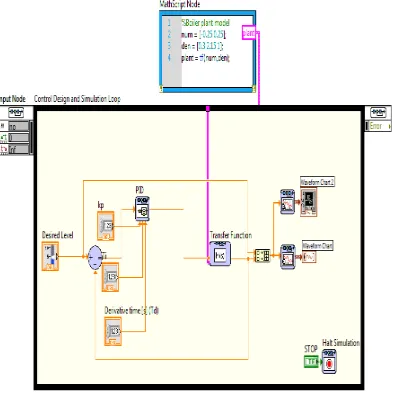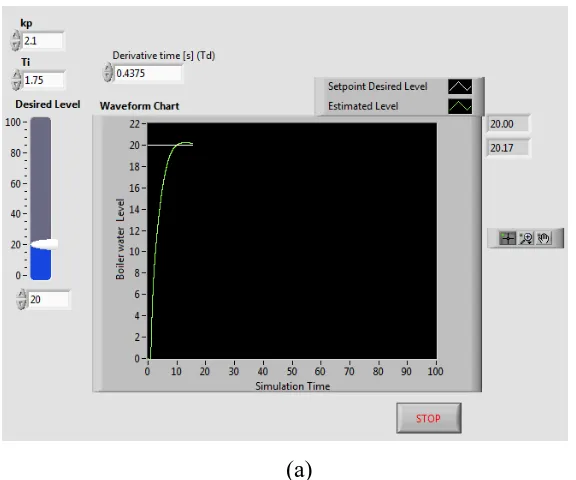Johnlouis et al. World Journal of Engineering Research and Technology
STUDY OF APPLICATION OF FUZZY-PID DRUM LEVEL CONTROL
FOR BOILER
Dr. C. Nagarajan1, P. Johnlouis*2, N. Balasubramaniyan3 and M. Hari4
1
Professor, Department of EEE, Muthayammal College of Engineering, Rasipuram, India.
2,3,4
Students, Department of EEE, Muthayammal College of Engineering, Rasipuram, India.
Article Received on 06/02/2019 Article Revised on 27/02/2019 Article Accepted on 17/03/2019
ABSTRACT
Boiler unit plays essential role in power plant and controlling the boiler
drum level is one of the important operations. Nowadays, conventional
Proportional plus Derivative plus Integral (P+I+D) control is being
used for this purpose. These conventional controllers in power plants
are not very stable when there are fluctuations. To overcome this and
to get better solution intelligent controller (fuzzy logic) is used to tune the conventional PID
controller automatically in online process through LabVIEW platform. In addition,
Conventional PID and Hybrid Fuzzy-PID controllers are compared. Hybrid Fuzzy-PID
controller result proves that, it offer better performance (in terms of settling time, rising time,
steady state error) than conventional PID controller in boiler drum level control.
KEYWORDS: Boiler Drum Level, Soft Computing, Hybrid Fuzzy-PID Controller.
INTRODUCTION
In power plants boiler drum is a closed vessel in which steam is produced by burning coal in
the furnace. The main input variable of the boiler drum are fuel, feed water and air. The
outputs of the boiler system are electrical power, steam pressure, steam temperature and flue
gas as shown in (fig.1.) According to these parameters the drum level may increase or
decrease. The boiler drum level should be monitored continuously. It should be within a
certain limited value. If the measurement of boiler drum level is not within the limited value,
water carryover may be occurred. If the level is low in drum overheating occur in boiler
World Journal of Engineering Research and Technology
WJERT
www.wjert.org
SJIF Impact Factor: 5.218*Corresponding Author
P. Johnlouis
If the value of level in boiler drums more than the limited value it may transfer the moisture
into the turbine, which reduce the boiler efficiency. P.Meenu.[1] is described the boiler drum
level control which is done by fuzzy logic controller. If the water level is too low in boiler
drum it leads to boiler explosion. If the water level is very in boiler drum it cause damage to
turbine due to the affect of separator steam water. Serious consequences occur in high or low
level so we must take strict control. Conventional Proportional integral derivative controller
is popular three element control. If there is any process disturbance the 3-element control
does perform well due to the lack of proportional controller gain knowledge .The collected
data from the PID controller is used to gain the knowledge on the intelligent control
technique and developed fuzzy logic control.
WATER FLOW INLET
STEAM FLOW OUTLET FEED WATER
CONTROL VALVE
DRUM
THREE-ELEMENT BOILER
DRUM LEVEL
Fig. 1: Basic Block Diagram of Drum Level Control.
Nagarajan,[2] is illustrated the water in the boiler drum has a nonlinear characteristics, large
time-varying, strong-coupling and multivariable. Using mathematical model of boiler drum,
fuzzy control theory is designed for controlling the boiler drum level system. Both fuzzy
logic and conventional logic are used in controlling the drum level. In MATLAB software
verification and simulation are done and get the result of drum level system. By observing
that static and dynamic characteristics of fuzzy controller is improved and also best real-time
control of boiler drum level is achieved.
Madheswaran,[3] explained the boiler drum level controlling using an intelligent model. In
three element boiler drum the parameters are determined using PID tuning methods like
Ziegler-Nicholas method, Tyreus-Luyben method and Internal Model Control in which IMC
The same author describes the approach for controlling a very crucial parameter of boiler
level of the boiler drum using PID controller. IMC based PID tuning method is used with
feedwater and feedback strategy is used to control two element drum level. Besides also the
modeling of the process for level control and implemented it in simulink. Hardware model
has also been developed and proved open loop validation for theoretically derived model and
practical model and simulation results. The boiler parameters are measured and controlled
using embedded system through LabVIEW. Water droplet identifiers are used to check the
steam dry or wet. Dry steam is required for power production, if wet steam passed to turbine
it will damage and production is affect. Water droplets identifiers detect the wet steam and
converted into dry steam.
Nagarajan,[6] presented the paper about the new development of the boiler-turbine
coordinated control strategy using fuzzy reasoning and auto tuning techniques. Boiler-turbine
system is a very complex process due to multivariable, nonlinear, slowly time-varying plant
with large settling time and a lot of uncertainties. The main stream pressure control loop and
power output are strongly coupled in boiler turbine unit. The automatic coordinated control of
two loops is very challenging problem. The Gaussian partition a special subclass of fuzzy
inference is used to self-tune the main steam pressure PID controllers.
Nagarajan[7] analyzed the work about possibilities of applying feedback linearization
techniques to the non linear control of super heat steam pressure and power output of
boiler-turbine generating unit. Computer simulation is used to design and evaluated the nonlinear
coordinated controller. The simulation results are helps to compare the proposed strategy
with conventional strategy. Improvements of nonlinear control system are observed by the
results.
Same Author describes the optimize control of the boiler in multi-zone heating system by an
inferential model-based predictive control scheme to save energy and to improve thermal
comfort. It has only three inputs they are outside air temperature, total solar radiation falling
on the exterior building and temperature of water in the boiler drum. Input-output data are
collected from the portable temperature loggers to estimates the parameter for the modeling.
The simulation results show that overall performance of the heating system is improved
Madheswaran,[9] designed self tuned PID controller for controlling speed of PMDC motor
with 49 fuzzy rules. Fuzzy rules are framed based on two fuzzy inputs “Error & Change in
Error” and three fuzzy outputs such as “Proportional gain(Kp), Integral gain (Ki) & Derivative
gain(Kd)”.Dynamically PID Controller parameters are updated through fuzzy interference
system in platform of LabVIEW.
PID Controller Boiler drum level Boiler steam output Fuzzy Tuning
KpKiKd
-+ Desired level Measured level
Fig. 2: Closed loop control for Boiler Drum Level Control.
The above block diagram (Fig.2.) presents the overview of proposed boiler drum level
control which consists of the following one major stage. The Hybrid Fuzzy-PID with self
tuning technique i.e. IF and THEN fuzzy control or rule base according to the error and
change in error that used to provide necessary actions to achieve optimal response through
the auto-selection of PID controller parameters.
Mathematical Modeling of Boiler Drum
The modeling of boiler drum is described based on steam drum, valve,[1] Transfer function
for steam drum is described in equation (1).
SET POINT PID Gv Gp
Gt Gd Gf Gm -+ + + + +
Fig. 3: Modeling Block Diagram of Boiler Drum.
0.25 0.25 2 2
( ) s
s s
Gp s
Transfer function for valve 0.25 0.25 3 2 0.25 S G pv
s s s
(2)
The equation (3) shows the series of process transfer function and valve transfer function
from the (fig.3.)
0.25 0.25 3 2 0.25 s G pv
s s s
(3)
The transfer function of the boiler drum is:
0.25 0.25
3 2
0.3 2.15
s G
pv s s s
(4)
Design and Implementation of Hybrid Fuzzy- PID Controller
In industrial control systems widely used controller is PID controller which is a generic
feedback control loop mechanism. Error value calculated by the PID controller is the
difference between a measured process variable (PV) and a desired set point (SP). In this
developed system fuzzy based rule is given to the PID controller for precise and faster
optimal response. It helps to achieve desired set point with minimum rise time and settling
time than conventional PID controller. The Basic structure of hybrid PID controller is shown
in (fig.4.) p I D d/dt TUNING FUNCTION DRUM LEVEL CONTROL + -+ + + + Tuning parameters Closed loop performance objectives Control function Control effort Disturbances Process variable Error
Fig. 4: Basic Block of Hybrid Fuzzy-PID Controller.
The relation between fuzzy input parameter(error and change in error) and fuzzy output
parameter(Kp, Ki and Kd) are given by the Hybrid Fuzzy- PID controller which is shown in
By the principle of fuzzy self tuning, the three parameters Kp, Ki and Kd are modified in order
to achieve control actions if there is any update in error and change in error for various level
as set point.
PID Process
Fuzzy System de/dt
Error =SP-PV
Kp Ki Kd
-+
Fig. 5: Basic structure of Hybrid Fuzzy-PID.
The error and change in error values are determined from previous set point values and
present set point values to perform good dynamic, steady state and static performance without
any disturbances. Five fuzzy labels (NL, NS, ZE, PS and PL) are framed for fuzzy input
parameters such as error and change in error values which are mentioned in Table I.
Similarly, six fuzzy labels (PVS, PS, PMS, PM, PL, PVL) are framed for fuzzy output
parameters as represented in Table II.
(a)
(c)
(d)
Fig. 6: Fuzzy Control of MF’s (a) Error “e” (b) Change in Error “ec” (c) Proportional Gain “Kp” (d) Intregral Gain “Ki”.
Start
Read Set point Level
If Error=0
(i.e) Setpoint level-Measured level=0
Compute Fuzzy inputs “e” & “ec”
Update Fuzzy outputs Kp=Kp’+ΔKp
Ki=Ki’+ΔKi
Kd=Kd’+ΔKd
Experimental Setup
This section is described simulation of conventional PID Controller and hybrid fuzzy-PID
controller action on drum level control. Conventional PID controller (existing approach)
parameters are tuned by using zeiglar-nicholas tuning methodology. The proposed approach
(fuzzy tuning) is achieved by trial and error method.
A.Conventional PID Controller Action on Drum Level Control
Fig. 8: Conventional PID controller simulation-Block diagram window.
The above simulation block diagram (Fig.9.) describes the conventional PID controller based
on the boiler drum level control. It consist of the transfer function of the boiler, conventional
PID controller and their parameter like proportional gain Kp, integral time i and derivative
(a)
In conventional PID controller the set point”20cm” is attained after 39 seconds. It takes more
time to settled due to overshoot present in the simulation results Fig.10 (a) & (b).
The above block diagram window (Fig.11) describes the simulation block of hybrid fuzzy-
PID controller based on the boiler drum level control. The simulation block is designed using
boiler drum model parameters. Membership functions and rule viewer for input and output
variables are available in the Fuzzy tuned controller.
(b)
Fig. 12: Simulation results for Hybrid Fuzzy-PID controller.
In hybrid Fuzzy-PID controller simulation results there is no overshoot. Using logic rules
Fuzzy controller is designed to rectify the overshoot which is occurred in the conventional
PID controller. Also settling time also decreased in Hybrid Fuzzy-PID controller. Here set
point “20cm” is settled at 27.5 seconds as shown in (Fig.12.)
Table III: Tentative Results Of Pid Controller Based Drum Level Control.
Set point Level Settling time ts (s) Rise time tr(s) Steady State Error in cm
25 % of Level 39.8 10.7 1.17
50 % of Level 47.3 10.7 1.57
75 % of Level 50 10.7 1.61
100 % of Level 54 10.7 1.67
Table IV: Hybrid Fuzzy-Pid Based Drum Level Control.
Set point Level Settling time ts (s) Rise time tr (s) Steady State Error in cm
25 % of Level 27.5 8.4 0
50 % of Level 27.4 8.6 0
75 % of Level 27.8 8.2 0
100 % of Level 27.4 8.7 0
CONCLUSION
The Conventional PID and Hybrid Fuzzy-PID Controller techniques are successfully
implemented for closed loop control of Boiler drum level control system. The performances
of two different controllers are analyzed by the investigation of settling time, rise time, dead
time and steady state error with simulation results. From the LabVIEW Platform based
simulation results, it is concluded that, the Hybrid Fuzzy-PID parameters are tuned
of the level. The Hybrid Fuzzy-PID controller offers the better performance control over the
conventional PID controller. While comparing with conventional PID controller
performance, Hybrid Fuzzy PID controller offers better dynamic response, shorter settling
time, rise time and zero steady state error.
REFERENCES
1. P. Meenu and G.Priya “Fuzzy logic Based Boiler Drum Level Control and Production System” in International Journal for Research and Development in Engineering, 2014;
255-260.
2. C.Nagarajan and M.Madheswaran, „Experimental verification and stability state space
analysis of CLL-T Series Parallel Resonant Converter with fuzzy controller‟ - Journal of
Electrical Engineering, 2012; 63(6): 365-372.
3. R.Raja and C.Nagarajan, “Performance Analysis of LCL-T Filter Based 2 Stage Single
Phase Gird Connected Module with ANN Controller using PV Panel," Current Signal
Transduction Therapy, 2018; 13(2): 159-167.
4. C.Nagarajan and M.Madheswaran, “Performance Analysis of LCL-T Resonant Converter with Fuzzy/PID Using State Space Analysis” Springer, Electrical Engineering, 2011;
93(3): 167-178.
5. E.Geetha, C. Nagarajan, “Stochastic Rule Control Algorithm Based Enlistment of
Induction Motor Parameters Monitoring in IoT Applications," Wireless Personal
Communications, 2018; 102(4): 3629–3645.
6. M.Madheswaran, C.Nagarajan, “DSP Based Fuzzy Controller for Series Parallel
Resonant converter”, Frontiers of Electrical and Electronic Engineering, 2012; 7(4):
438-446.
7. C.Nagarajan, “Single-Stage High-Frequency Resonantac/AC Converter Using Fuzzy Logic and Artificial Neural networks‟, Conference on Emerging Devices and Smart
Systems (ICEDSS), 2nd and 3rd March, organized by mahendra Engineering College,
Mallasamudram, 2018; 30-37.
8. E Geetha, C Nagarajan, “Induction Motor Fault Detection and Classification Using Current Signature Analysis Technique”, Conference on Emerging Devices and Smart
Systems (ICEDSS), 2nd and 3rd March, organized by mahendra Engineering College,
Mallasamudram, 2018; 48-52.
Systems (ICEDSS), 2nd and 3rd March, organized by mahendra Engineering College,
Mallasamudram, 2018; 38-41.
10. CS Lakshmi, C Nagarajan, “Neural Controlled Multi-Level Inverter Based DVR for Power Quality Improvement”, Conference on Emerging Devices and Smart Systems
(ICEDSS), 2nd and 3rd March, organized by mahendra Engineering College,
Mallasamudram, 2018; 42-47.
11. S Thirunavukkarasu, C Nagarajan, “Performance Analysis of BLDC Motor Drive for Feed Drives”, Conference on Emerging Devices and Smart Systems (ICEDSS), 2nd and 3rd
March, organized by mahendra Engineering College, Mallasamudram, 2018; 67-70.
12. JP Daniel, C Nagarajan, “Hybrid Filter for Distorted Voltage Source in Microgrids”,
Conference on Emerging Devices and Smart Systems (ICEDSS), 2nd and 3rd March,
organized by mahendra Engineering College, Mallasamudram, 2018; 11-15.
13. K Umadevi, C Nagarajan, “High Gain Ratio Boost-Fly Back DC-DC Converter using Capacitor Coupling”, Conference on Emerging Devices and Smart Systems (ICEDSS), 2nd
and 3rd March, organized by mahendra Engineering College, Mallasamudram, 2018;
64-66.
14. C.Nagarajan and M.Madheswaran, “Experimental Study and steady state stability
analysis of CLL-T Series Parallel Resonant Converter with Fuzzy controller using State
Space Analysis”, Iranian Journal of Electrical and Electronic Engineering, 2012; 8(3):
259-267.
15. Santhana Lakshmi and C. Nagarajan, “Multiconverter Technology Based Voltage Compensation for Photovoltaic System” Ecology, Environment and Conservation, 2017;
23: 226-229.
16. C.Nagarajan and M.Madheswaran, ”Stability Analysis of Series Parallel Resonant Converter with Fuzzy Logic Controller Using State Space Techniques”, Electric Power
Components and Systems, 2011; 39(8): 780-793.
17. C.Nagarajan, M.Muruganandam and D.Ramasubramanian – „Analysis and Design of
CLL Resonant Converter for Solar Panel - Battery systems- International Journal of
Intelligent systems and Applications, 2013; 5(1): 52-58.
18. C.Nagarajan and M.Madheswaran, “Experimental Study and Comparative Analysis of
CLL-T and LCL-T Series Parallel Resonant Converter with Fuzzy/ PID Controller”,
Journal of Electrical Engineering, 2011; 11(3): 122-129.
been presented in ICTES‟08, a IEEE / IET International Conference organized by
M.G.R.University, Chennai, 2007; 1: 190-195.
20. Nagarajan, M.Madheswaran and D.Ramasubramanian, “Development of DSP based
Robust Control Method for General Resonant Converter Topologies using Transfer
Function Model,” Acta Electrotechnica et Informatica Journal, 2013; 13(2): 18-31.
21. S.Sathish Kumar and C.Nagarajan, “Performance - Economic and Energy Loss analysis
of 80 KWp Grid Connected Roof Top Transformer less Photovoltaic power Plant,”
Circuits and Systems, 2016; 7(6): 662-679.
22. Padmapriya S, Kumar R., “E-Tracking System For Municipal Solid Waste Management Using RFID Technology”. International Journal of Advanced Research in Electronics,







